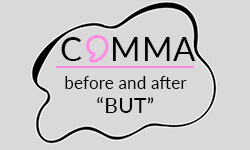
The use of commas often causes confusion among students, leading to errors in academic writing. This regularly happens due to the fact that many are unaware of the exact rules and the exceptions. This article seeks to elucidate the specific rules and considerations that govern the usage of commas before and after the conjunction “but”, offering clarity through examples and explaining exceptions to the rules.
When to place a comma before “but”
In general, a comma must be placed before the conjunction “but” when two independent clauses are joined. An independent clause defines a sentence that contains a subject-verb agreement or a part of a sentence that can stand on its own. There are also set rules, where a comma is not necessary, as illustrated below.
Comma
Stylistic choices
Linking two independent clauses
No comma
Dependent clause following “but”
Starting a sentence with “but”
Comma rules may vary depending on different Style Guides. Moreover, some complexly structured sentences may also have exceptions regarding placing commas. It is always useful to consider whether your sentence is easy and clear to read without a comma.
Comma before “but”
When joining two independent clauses, a comma is generally necessary before “but.” Sometimes, a comma before “but” should be included for clarity and emphasis, although it does not join two independent clauses.
Stylistic choices
Using a comma before “but” can highlight the contrast between two independent clauses and provide a pause in reading, allowing the reader time to process the information presented in the first clause before moving on to the contrasting one. In addition, if the second clause of the sentence contains an unexpected or surprising event, using a comma can amplify this effect. Particularly in longer sentences, a comma can enhance readability and comprehension.
Linking two independent clauses
A comma is used before “but” when linking two independent clauses to clearly indicate to the reader that a separate, yet related, thought is about to be presented. It serves as a pause and helps to prevent misreading.
An independent clause is a group of words that contains a subject and a verb, and it expresses a complete thought. It could stand alone as a complete sentence if necessary.
No comma before “but”
Generally, there are three rules that state that there should not be included a comma before “but”: When “but” is included in a single sentence, when “but” joins an independent clause with a dependent clause, or when a sentence begins with “but.”
Dependent clause following “but”
A dependent clause can be determined by checking whether it can stand alone or not. If this is not the case, the clause is dependent and a comma should not be placed before “but.”
Starting a sentence with “but”
Although starting a sentence with “but” is typically perceived as informal and stylistic, it is widely accepted in English writing. However, there should not be placed a comma before or after “but.”
Comma after “but”
The only case when a comma is placed after “but” is when “but” is followed by a parenthetical statement or an interrupter. Interrupters define the context that adds emphasis to a sentence or extra information.
Test yourself!
Practice sheet
Test your understanding of using commas before or after “but” by placing them in the right positions in the 10 sentences. You can then find the correct answers in the second tab to check if you grasped the right understanding.
- I love swimming but hate cold water.
- We wanted to visit the theatre but given the weather we decided to stay in.
- It’s an old but functioning car.
- She doesn’t say much but when she does everyone listens.
- The pie looked delicious but surprisingly had an awful taste.
- He wanted to go to the festival but he had prior commitments.
- She aimed to finish the test but unfortunately, she ran out of time.
- We would like to order takeout but can’t afford it.
- I love the fit of the pants but not the color.
- She wanted to join gymnastics but due to her injury she couldn’t
- I love swimming but hate cold water.
- We wanted to visit the theatre but, given the weather, we decided to stay in.
- It’s an old but functioning car.
- She doesn’t say much, but when she does, everyone listens.
- The pie looked delicious but, surprisingly, had an awful taste.
- He wanted to go to the festival, but he had prior commitments.
- She aimed to finish the test, but, unfortunately, she ran out of time.
- We would like to order takeout but can’t afford it.
- I love the fit of the pants but not the color.
- She wanted to join gymnastics, but due to her injury, she couldn’t.
- ✓ Free express delivery
- ✓ Individual embossing
- ✓ Selection of high-quality bindings
FAQs
A comma is only to be placed after “but” when it is followed by a parenthetical statement or interrupter.
Example: She wanted to join us, but, because of her prior plans, she couldn’t.
No, there are rules for when a comma should be placed before “but” such as when two independent clauses are connected, for emphasis or clarification, and when “but” connects an independent clause with an introductory phrase.
In less formal conversations, starting a sentence with “but” is acceptable in the English language. It is mainly used to add emphasis or introduce a contrasting idea.
